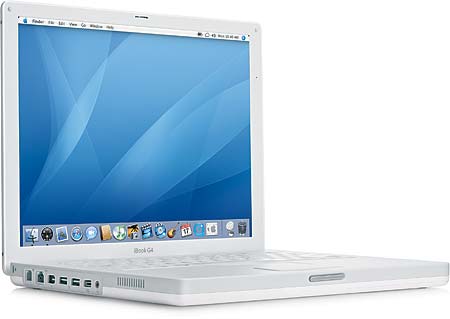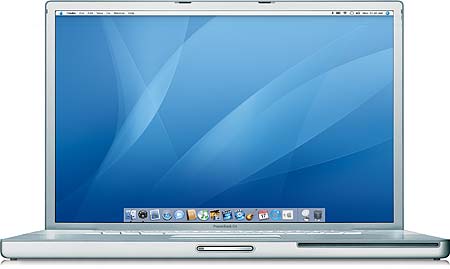Home Search Gallery How-To Books Links Workshops About Contact
Laptop
Computers for
Digital Photography
Apple
iBook: The $999 laptop from 2004 from which this website came. Note: I wrote this back in 2006. Today, in 2007, most of this page is out of date and most of the links have dried up and blown away. Luckily, since in 2007 I personally still use Apple's crummiest laptop from 2003, anything you can get from Apple today is more than enough for photography and web design and everything. Just be sure to get all the RAM and the biggest optional hard drive you can, and be happy! Processor speed hasn't been relevant for a long time. MacBook Pro (Intel) This was first sold on 15 February 2006. It uses Intel processors instead of Apple's traditional Motorola PowerPC processors. It's a great machine, but the Intel processors can be a bit of a problem until all the software we use is updated to, and we buy and pay for, new versions. See my Macs with Intel Processors page. iBook (PowerPC) I bought my now two-year old 12" iBook because it has longer battery life and a more durable case than the more expensive Powerbooks. The 14" iBook has the same screen resolution; it's just a little bigger and enlarges the same screen just a little bit more. You can't fit anything more on the same 1024 x 768 pixel screen of the 12" or 14" iBook. The white plastic case is polycarbonate, the same material used in motorcycle helmet visors and bulletproof glass. You'll pulverize your laptop's insides before the outside will break. My only complaint is that my kiddie iBook can't drive an external monitor at any greater than 1,024 x 768 resolution. It drives my 22" CRT just fine, just that it's just the same screen made huge. Readers have referred me here (also here, here and here) for a hack that allows an iBook to drive an external monitor bigger than 1,024 x 768. This hack also reportedly allows the external monitor to work independently of the built-in, and not merely mirror it. My iBook is great because the processors are all off to one side of the case away from the battery. Therefore the battery doesn't get hot which greatly improves its service life. Most laptops get hot all over so they literally fry the batteries when used plugged in. This is why so many other laptops need a new battery every year even if they are almost always plugged in. After almost two years my iBook still runs about 3.5 hours on a charge, and that's working it hard. If I turn the screen up all the way and beat on it it might only run 3 hours, and if I dim the screen and just do normal things like read email I'll get 4 hours, even on OS 10.4.3. Apple cautions never to use a laptop on a bed, blanket or with the rubber nubbins removed from the bottom. Laptops are designed to cool with airflow underneath. This airflow would be stopped if the laptop sat directly on top of something without the tiny airspace below. The iBook also has a small fan which probably will never run for most users. it was a year until I finally got it to go. Only if you really beat on the iBook with a lot of continuous processing will the fan ever come on. Not that that's bad; it just means you're making your iBook work for a change. The fan is either on or off, with no speeds in between. It sucks in from the left and blows out the back. PowerBook (PowerPC) PowerBook (Courtesy of Apple) You (and I) might prefer an aluminum-cased PowerBook because it can drive any monitor, even the gargantuan 30" Apple Cinema Display. The PowerBook also can drive the external monitor at the same time as its own screen, so you now will have two screens working on your desk. As always, it's trivial to set them up to work together. Your mouse and everything simply glides across the two screens as if they were one. The 15" and 17" models also have a PCMCIA slot into which you can insert a card reader, eliminating the need for the external reader I carry, and I prefer the front loading CD/DVD slot compared to the iBook's side-loading. The 12" PowerBook can't drive the gargantuan 30" display; you'll have to settle for the merely huge 23" display. All 12" and 14" iBooks and 12" PowerBooks have standard 1,024 x 768 pixel screens. The 15" Powerbook, as of November 2005, just jumped up to 1,440 x 960 pixels. The 17" Powerbook, as of November 2005, just jumped up to 1,680 x 1,050 pixels. Unlike the Apple Cinema Displays, all the laptops have LCDs which look lighter from above and darker from below. This is borne out in the angle-of-view specifications. It's never been a problem for me even on my 12" iBook and I've never seen a laptop that's any different. NEXT > > DESKTOP MACS BACK: OPTIONS, MEMORY AND HARD DRIVES Return to top of COMPUTER RECOMMENDATIONS |




